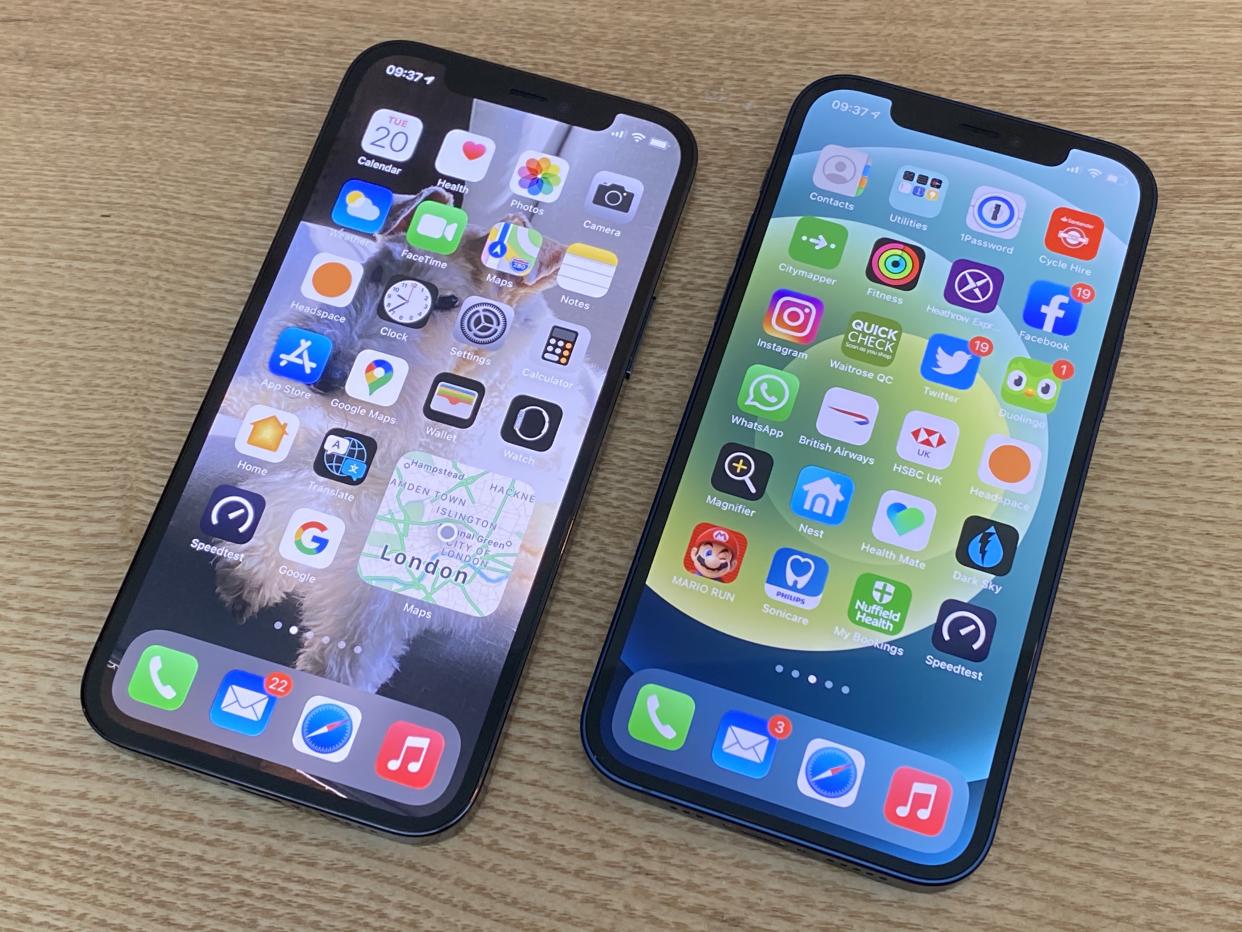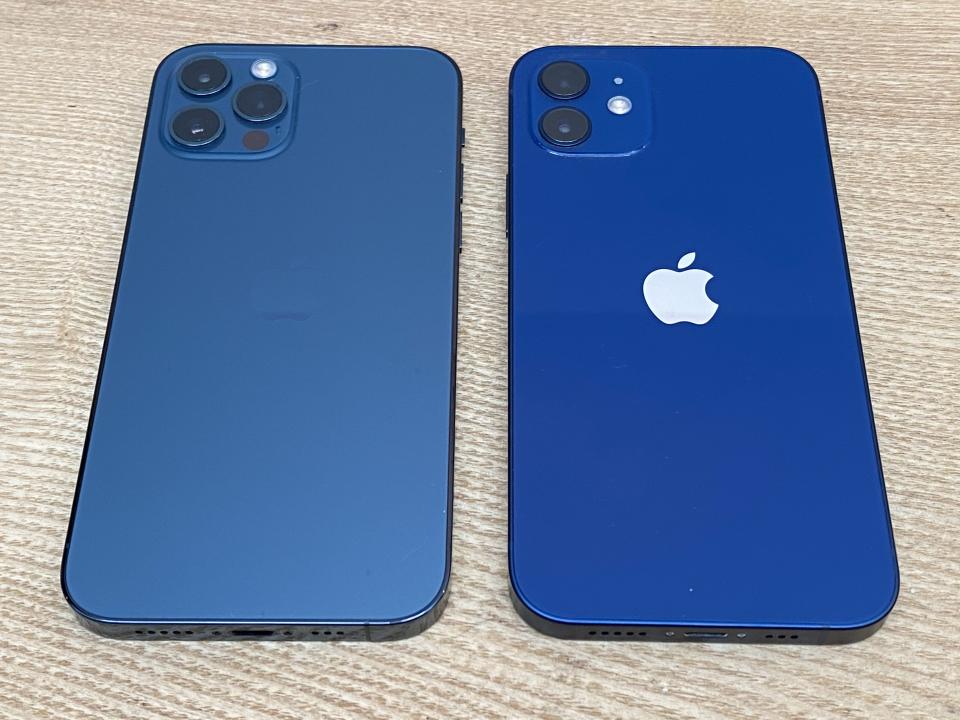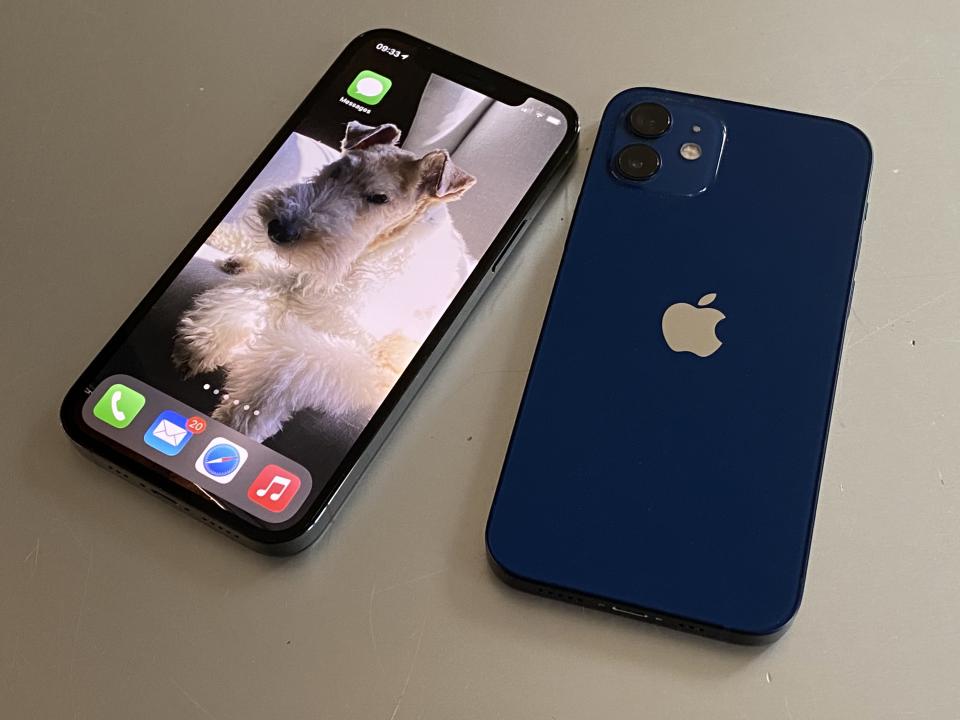iPhone 12 and 12 Pro UK release: New design, 5G and other features reviewed

It’s here: for the second time in two years, we’ve had a whole-number jump in iPhones – no iPhone 11S in between as might have been expected. With Apple, that indicates that we should expect both a completely new design and significant upgrades to the phone’s internals.
For the first time, this launch sees four iPhone 12 models, more iPhones than ever before: two are available this Friday, 23 October, with two more coming in November.
In all, there are the little iPhone 12 mini (5.4in display) and huge iPhone 12 Pro Max (6.7in display), both landing next month.
This week, though, the first arrivals are the iPhone 12 and iPhone 12 Pro, each with the same size screen, 6.1in. That screen size makes these two phones the Goldilocks phones, just right for most people.
There’s much that ties all four of these phones together: they have the same super-fast A14 Bionic processor, matching industrial design in terms of a flatter shape, and the Ceramic Shield on the front which Apple says is four times better at surviving a drop than before and is tougher than the glass on any other smartphone. I haven’t deliberately tested this, though certainly the screen hasn’t suffered any damage in the smallish drops I’ve accidentally let happen.
Watch: iPhone 12 unboxing ahead of launch on Friday
Where the iPhone 11 had rounded edges and a pillowed display - every edge and surface was curvaceous – this time there are flat edges and a flat display front and back. Only the corners are rounded. These right-angled edges are noticeable, though not uncomfortable, as you hold it. We don’t yet know if it will be as comfortable in the larger iPhone 12 Pro Max, but here it’s a snug and easy fit in the hand.
And all four phones are 5G-capable – unlike any iPhone before.
The thing is, 5G is very big for the iPhone, but the iPhone is even bigger for 5G. Expect networks to build out their 5G masts much more aggressively now that the iPhone can benefit from the lightning-fast connections and almost-imperceptible latency that 5G offers.
Anyway, on to the differences between the two phones. The iPhone 12 has a glossy back with a matte panel for its two rear cameras. The 12 Pro reverses the sheen with a matte back and glossy panel, while adding an extra camera which works as a telephoto, and a LiDAR scanner, a small circular sensor which is great at quickly grabbing depth information as you shoot.
The rear of the iPhone is the purest-looking yet from Apple. Aside from the camera panel, there’s just a shining Apple logo, centrally placed. There isn’t even the CE marking found on the iPhone 11. That’s been moved to the edge (a side-benefit of having a flat design).

Then there’s the display: the bezels around the iPhone 12 screen are noticeably slimmer than the iPhone 11, so the phone is smaller, despite the same-size screen. It’s OLED this time, where the iPhone 11 display was LCD. The screen resolution on the iPhone 12 is upgraded, too, from a pixel density of 326 pixels per inch to 460ppi. That’s the highest pixel density yet seen on an iPhone (though next month the iPhone 12 mini will beat it with its 476ppi screen).
Last year’s iPhone 11 Pro already had an OLED screen, measuring 5.8in. This time around the screen is increased to 6.1in, though the phone feels about the same in the hand as the iPhone 11 Pro, despite being fractionally taller. The display is near-identical on iPhone 12 and iPhone 12 Pro, the only difference being that the Pro has greater brightness.
The final design difference between the two is the edge: it’s aluminium on the iPhone 12 and a gleaming stainless steel on the Pro. In both cases, the edge metal is colour-matched to the shade on the rear of the phone. There are plenty of colours to choose from, by the way: on the iPhone 12 there’s black, white, PRODUCT(RED), a delicate pastel green and a sumptuous deep blue, with just a touch of the peacock about it.
For the iPhone 12 Pro, the choices are silver, a punchy gold and graphite, which is not as black as previous iPhones but has a dark intensity to it. The newest colour on the block is Pacific Blue, which is almost grey in artificial light but glints steely blue in daylight. It’s a subtle, attractive shade.
The design overall is very appealing, a clear descendant of the iPhone 5, tailored to modernity with a bigger, all-screen front, more cameras and improved materials.
Cameras
Our phones are our cameras now. Even the most ardent of amateur photographers is more likely to take a snap using the phone in their pocket before the D-SLR in their bag, I’d guess.
Exactly how much photographic control you want will determine which of these two phones is right for you. The iPhone 12 has a wide-angle lens and an ultra-wide. The 12 Pro has those two and adds a telephoto, plus a cool LiDAR scanner which is used for augmented reality apps, still in their infancy, but also to grab depth information quickly in photos. All three camera sensors have 12-megapixel resolution.
In both cases, the camerawork has got even better this year, with a new seven-element lens structure on the main camera that enables a wider aperture. In turn, this grabs more light more quickly, for instance, to improve low-light performance.
But Apple’s skill is as much its range of technological additions such as night mode which adds light to dark scenes through long exposures, brightening them so realistically that you’ll think the iPhone has been eating more carrots than you. Deep Fusion, a system introduced last year which uses machine learning to improve details such a fabric texture, is now available on all rear cameras and the front-facing snapper, too, on both iPhone 12 and iPhone 12 Pro.
There’s scene recognition now, also based around machine learning, so the phone sees whether you’re taking pictures of your food, your dog or your surroundings and adjusts accordingly.
All of these things require image processing. These are dirty words for some camera purists but the reason it works with the iPhone is that Apple’s engineers have exceptionally good taste. As a result, the photos sometimes seem to capture not the reality, but your memory. How it felt, even more than how it looked.
These are the best cameras yet on an iPhone, perhaps on any phone.
And I haven’t even mentioned the video recording which, uniquely, includes recording in Dolby Vision, so it can capture more colours, adding fidelity and realism.
MagSafe
The new iPhones also see the arrival of MagSafe for iPhone. This takes the form of a wireless charger designed just for the iPhone 12 – sold separately. The phone contains a ring of magnets which mean it attaches firmly to a corresponding ring in the MagSafe charger. If you’ve ever used wireless charging, you’ll know it’s tremendously convenient… unless you don’t put it down just right and your battery is flat in the morning. With MagSafe, this will be a thing of the past.
Apple has also made a series of iPhone 12 cases which take advantage of this, allowing a graceful, easy fit and extra features, such as the way the iPhone cleverly recognises which colour case you’re attaching, and even flashes the screen in the matching colour as you attach it. It’s very cool.
Performance
This is a spectacularly fast smartphone. The processor at its heart is a big part of that. The A14 Bionic processor on the new iPhones, all four models, regardless of price, is dazzlingly fast, outstripping the competition, Apple says. Independent benchmarks back this up.
Mind you, the A13 Bionic in the iPhone 11 was blazing-fast, so with most activities it’s hard to spot much change.
But the big change with the iPhone 12 series is that it now comes with 5G, ensuring that you’re not slowed down by an iffy cellular connection. Although the networks have a long way to grow, testing the connection on the iPhone 12 and iPhone 12 Pro in London delivered stellar speeds, faster than I’d ever managed on an iPhone before. Downloading the latest episode of Star Trek: Discovery on Netflix was very fast, and playback was pristine and pin-sharp.
Last year, the battery life on the iPhone 11 took a turn for the outstandingly better. In the last year, the only time I have had to recharge an iPhone during the day was when I was in a rural area with no cell coverage, so the phone was constantly looking for a signal it couldn’t find. Otherwise, full-day battery life has been my consistent experience.

The danger, this year, is that it could have fallen back again, with the demands that 5G, especially, might bring. It’s early days but my experience has been strong, consistent battery life that has romped through a full day easily, with plenty to spare. It’s on a par with last year’s iPhones.
Verdict
Apple has said that one of the initial drivers in iPhone design was a machine where there was just you and the screen you’re immersed in, whether that’s typing an email, watching a movie or playing a game – an intimate relationship.
The iPhone 12 and iPhone 12 Pro are easily the most successful realisation of that ideal. They create a connection that is instinctive first, intellectual second.
That’s because the display covers the entire front, the phone unlocks when it recognises you, the software is completely intuitive and the touchscreen is responsive.
Its speed is impressive and as more demanding apps and games are released, could prove to be game-changing. It may lead to the elusive killer app for 5G. Just as 4G gave us Netflix, Deliveroo and Uber, so 5G should yield something similarly amazing, but it’s not appeared yet.
Both these iPhones are dreamily good with the performance uplift from the A14 Bionic chip and 5G worth the price alone. Which, by the way, are £799 for the iPhone 12, £999 for the iPhone 12 Pro.
The iPhone 12 series represents the biggest single-year upgrade of any iPhone yet. If you’re into photography, the iPhone 12 Pro is the first choice, offering an extra lens for much more versatility. There’s also the attractive stainless-steel frame on the Pro to tempt you. However, great though the 12 Pro is, it’s the iPhone 12’s improvements compared to the iPhone 11 which really stand out, and make it the best-value iPhone.
Watch: What are negative interest rates?
Read more
The best pre-order deals for the iPhone 12, mini, Pro, and Pro Max

 Yahoo News
Yahoo News 
